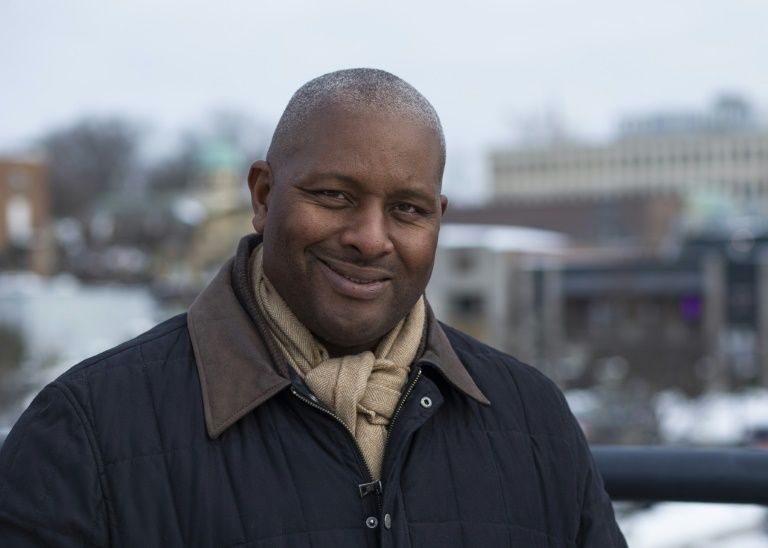Black on Wall Street: A profile of 3 professionals
Dale Favors has had white mentors on Wall Street, but says knowing other African-American colleagues has been essential. ©AFP Kena Betancur
New York (AFP) – Being Black on Wall Street has often meant entering a crowded room and seeing nobody else who looks like you.
This is changing, but not that fast. Here are three accounts that shed light on the challenges and benefits of that experience.
– Experiencing ‘social acclimation’ –
Before starting his own consulting firm, Dale Favors worked for leading financial giants including Morgan Stanley, CIBC, Royal Bank of Canada and Piper Jaffray.
One critical element in his early career was the magazine “Black Enterprise” and its list of the top 25 Blacks on Wall Street.
In 1992, “I read that magazine from cover to back cover probably 200 times,” recalled Favors, who proceeded to call the names, one by one.
“That article there allowed me to identify the names and pictures of people who looked like me working on Wall Street. And I knew I could do it.”
He enjoyed the work in his first role in fixed income securities at Morgan Stanley. He had the technical skills for the job, but went through a process of “social acclimation,” he said.
“I had to get properly socialized into an environment that was very much Caucasian,” he recalled.
Favors has had white mentors, but says knowing other African-American colleagues has been essential. One of his mentors at Morgan Stanley was Craig Robinson, brother to former First Lady Michelle Obama.
“We all go through unique experiences being people of color on Wall Street,” he said. “To have other people to talk to about that, that’s so important.”
He appreciates that banks are hiring more from public universities and historically black colleges, but notes that recruits may still need a hand learning the office lingo or getting used to meetings where everyone else is white.
“To make change, you have to be very deliberate,” he said.
Favors praises some recent steps, such as a Goldman Sachs requirement that clients seeking to go public include a woman or minority board member.
“Now that there’s data showing that if you have diversity, it can turn into more money, people pay attention,” he said.
– Navigating two worlds –
Life on Wall Street as a Black woman can be enriching but also be “isolating,” according to Johnita Walker Mizelle.
“Every day in the office, I have to conform to your norm, because it’s the norm of the majority,” she said.
“I didn’t grow up learning how to ski. I did not grow up going to a big university with a large football team. I did not grow up with an uncle who was a stockbroker. Going for a beer after work just wasn’t part of my culture.”
Black employees must manage a juggling act not required of white workers.
“I show my colleagues that I can relate to them in their cultural norms, whereby there’s never the case where they have to do that for me,” she said.
When she began her career in 1996, Mizelle was the only Black woman on the trading floor of her firm who wasn’t a secretary.
“It’s isolating,” said Mizelle, who values working for the venture capital firm Anthemis, which is led by a woman.
Wall Street is not a pure meritocracy and career trajectories can be affected by economic cycles or the presence of a well-placed mentor.
In such a hyper-competitive environment, there can be advantages to fitting in — by musical taste, food preferences, or fashion sense — which can penalize minorities, according to Mizelle.
Mizelle credits a stint at Black-led Williams Capital with opening her eyes to possibilities, saying “I really do believe you cannot be what you can’t see.”
Mizelle studied chemistry, but came to Wall Street following a chance introduction and visit to Goldman Sachs, her first Wall Street job.
“I fell in love with the markets,” Mizelle said.
She still feels that way, although being Black on Wall Street means “your work ethic becomes that much stronger,” she said.
“Every project you get is an opportunity, not just for you but for the Blacks and Hispanics they’re going to hire behind you.”
– Battling stereotypes –
Harold Butler is far from a lifer on Wall Street.
He didn’t arrive at Citigroup until 2006 near the end of his 40s, after a trajectory that included working at Microsoft and elsewhere in finance. His role today involves managing the bank’s relations with public entities, including the Federal Reserve.
“It’s common for most African Americans to have experienced some sort of racism, whether it’s being made to feel like the other, individuals asking me whether or not I was here because of a quota, or having to disprove stereotypes” like African-Americans’ supposed outsized love for watermelon or fried chicken.
“Some people just do it unconsciously. They don’t really understand their words or their thoughts, and how it impacts people.”
But at Citi, Butler has felt supported in efforts to diversify the bank’s staff and larger impact.
The bank has stepped up efforts to recruit from underrepresented groups and bolstered mentoring and other initiatives to try to retain staff and better understand the roadblocks that sometimes drive promising African-Americans out of the field.
Butler is leading a program through which Citi mentors minority-owned banks, opening more doors for them, bringing them more capital and technical help.
It is a way of expanding credit access for more African-Americans who need a mortgage.
“I have the good fortune of being a part of everything that we’re doing to do good to help change the narrative inside Citi, and our efforts around diversity and inclusion, and the work that we’re doing outside the bank to impact communities,” he said.
Disclaimer: Validity of the above story is for 7 Days from original date of publishing. Source: AFP.


